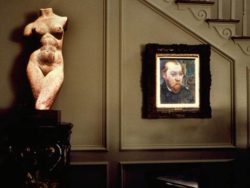Art Light Placement

Proper art light placement takes real planning, as it’s not just about filling the space with illumination. Unlike standard fixtures, which are used to brighten up an entire room, display fixtures are aimed precisely at a subject and have to be shaped to maximize the effect. This means accounting for things like glare and shadows, and setting up the fixture so that it produces the optimal beam angle. An illumination expert can help overcome these obstacles and prevent the frustrating trial and error that often comes with setting up fixtures.
Why is proper art light placement important?
Homeowners invest thousands of dollars into their paintings and sculptures, and hundreds into fixtures to display them. In short, it’s a big deal that the display look as sophisticated as possible. Even the smallest mistake can make the fixtures look off or sloppily arranged. For a homeowner that takes pride in their collection, poor illumination can be a nightmare.
An optical framing projector may appear simple to set up. Just point it at the painting or sculpture and switch it on, right? The problem with trial and error is that holes have to be cut out of the ceiling to make space for recessed projectors. The goal is to find the correct spot before installing the fixture and anchoring it to the ceiling.
What challenges are associated with art light placement?
Beam angle, glare reduction and removing shadows are the most important considerations when placing an optical framing projector. Finding the right beam angle is essential because it will determine how narrow or wide the spread of illumination is. If the beam angle is too narrow, the edges of the painting or sculpture may appear darker than they should. If the beam angle is too wide, there will be too much spill, affecting the overall look. Phantom’s optical framing projectors are designed with a special lensing apparatus that allows for multiple beam angle settings, giving the projector a bit more flexibility during installation.
Glare is almost always present when the painting is placed under glass or when it is made with oils. If the glare reflects off the painting from normal viewing angles, it will ruin its appearance. Fortunately, an expert can control where the glare goes by measuring the angle of incidence as the beam strikes the painting. So, if the beam strikes the painting from the right at a shallow angle, the glare will reflect off the left side. With the proper setup, the beam will strike the painting so that there is no glare when viewing the subject from most common angles.
Shadows are a simpler problem, as they are typically caused by deep frames. Either switching the frame out or arranging the fixture to compensate will get rid of annoying shadows.
Once the projector is set up, it can be masked with a set of adjustable shutters or a metal template, allowing for finer control of the beam shape. This, along with the correct placement will ensure the display is worthy of the subject.
